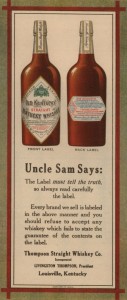 So, is it spelled Whiskey or Whisky? The 1st thing that needs to be understood is that there exist 2 accepted spellings. The Scotts and Canadians spell whisky with no “e”, whilst the Irish and Americans spell it with an “e”, whiskey. This should be the first sign that the world of whiskey is a very complicated one. Each region has a number of variations in raw materials used, techniques in production which dictates the ultimate taste and characteristics. This is part of what makes whiskey a fascinating and enjoyable spirit.
So, is it spelled Whiskey or Whisky? The 1st thing that needs to be understood is that there exist 2 accepted spellings. The Scotts and Canadians spell whisky with no “e”, whilst the Irish and Americans spell it with an “e”, whiskey. This should be the first sign that the world of whiskey is a very complicated one. Each region has a number of variations in raw materials used, techniques in production which dictates the ultimate taste and characteristics. This is part of what makes whiskey a fascinating and enjoyable spirit.
Historically it is theorized that the Irish were the first to make whiskey, however the Scots have also laid claim to being the first whisky makers. The Irish used the term “uisce beatha” or “Water of Life” in Gaelic to describe whiskey. This suggests that it was an important part of daily life.
Both Scottish and Irish make whiskey in similar ways, with the exception of the malting and distillation process. In Scotland the malted barley is dried in peat fired kilns. The malted barley accumulates the peat flavor providing Scotch whisky its one of a kind taste. In Ireland, the malted barely is dried out in enclosed ovens, never being exposed to the smoke. The method of mashing and fermentation is much the same for both places. During distillation the Irish normally distill the fermented mash 3 times, which leads to a very pure distillate which makes Irish whiskey remarkably smooth. However, the distillate cannot exit the still at more than 94.8% ethanol. The Scottish distill their product twice resulting in a more flavoured spirit.
In North America there is Canadian whisky and American whiskey. Each region has a numerous regional classifications which includes Bourbon and Tennessee whiskies. Each product in North America is unique and is regulated by the government. Canadian whisky is the number one imported spirit into the U . S . and is second in consumption only to vodka.
American whiskey has a number of regulations depending on the type of the product being made. As an example, Bourbon has to be produced from fermented mash of no less than 51% corn. If it uses more than 79% corn in the mash it’s considered Corn whiskey. Bourbon cannot be distilled to a proof higher than 160. It must also be matured in new oak barrels at a proof of 125 or less. Blended American whiskey must be made from a minimum of 20% whiskey aged two or more years with the remainder produced from unaged neutral grain spirit. American corn whiskey must be crafted from a minimum of 80% corn in the mash. Tennessee whiskey follows the identical regulations as bourbon. However, it is charcoal filtered via a technique known as the “Lincoln County Process.” Thus, it doesn’t qualify as a bourbon.
Canadian whisky must be aged for a minimum of 3 years. However, the Canadian government permits the experience of the distiller to define the characteristics of the final product. This means there aren’t any limits on distillation proof or barrel aging requirements. Any Canadian whisky that is matured for under four years needs to have the age printed on the bottle. Most Canadian whisky is aged for 6 or more years. Canadian whisky is usually a blended spirit. The term “blended” means that the final product is produced from a number of various distilled products. For example, a Canadian whisky may be composed of corn, barely, wheat and rye whisky which have been matured in neutral (used) or new oak barrels. A number of Canadian producers put all the grains in one tank and ferment them together. Following that they will distill, pre-blend and age the blend. Other producers ferment each grain mash individually followed by distillation and aging. The final products will be blended to create the final product. Most Canadian whisky is twice distilled.
Recent Comments